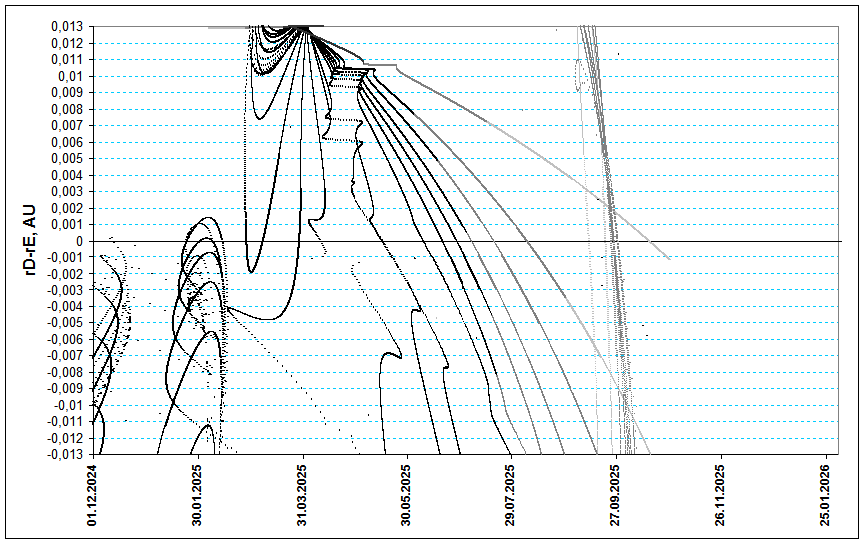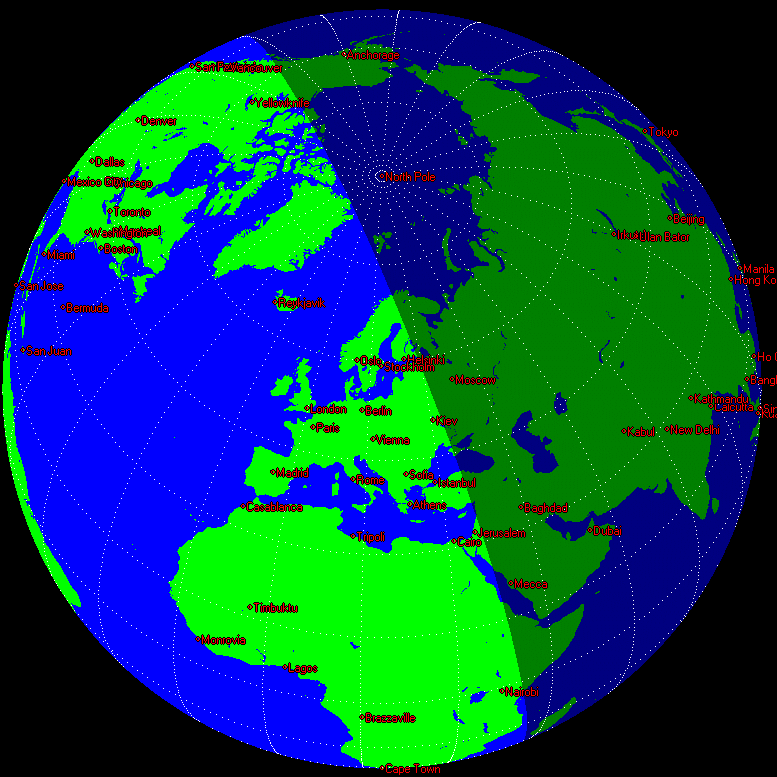Draconids 2025: prediction of activity
to the list of predictions

Fig. 1. Space-temporal projection of the Draconids trails parts onto their minimal distance passages in 2025 (correspondence between colours of the particles and their ejection velocities can be seen here).

Fig. 2. Detailed space-temporal projection of Draconids trails parts onto their minimal distance passages in 2025 (correspondence between colours of the particles and their ejection velocities can be seen here).
In 2025 the comet 21P/Giacobini-Zinner passes its perihelion and this apparition is the last when the comet's orbit is very close to the Earth's one. By the next perihelion in 2030 its perihelion distance will increase from 1.01 to 1.07 AU due to close passage to Jupiter in 2029 and in the next several decades till 2067 it will vary between 1.07 and 1.10 from apparition to appartion. This will significatly worsen perspectives of the Dracondins activity thouth not completely extinguishing them in the following decades.
The computaions show that in 2025 the Earth passes near very young trail of the comet 21P/Giacobini-Zinner, which was ejected in 2012. Computed distance to the trail is 0.00065 AU, ejection velocity of particles is 90.1 m/s, density of the trail is 8.02 times higher than that of a 1 revolution Leonids trail, time of maximum is 15:07 UT on October 8. So far 2012 trail is a regular (not perturbed) cometary trail with high computed density, but it encounters the Earth with its part composed of particles with very high ejection velocity, which are peculiar to very small particles, vast majority of which could produce very faint or even invisible meteors. This feature drastically reduces expectations of activity, a very short outburst with ZHR of 100-150 is expected so far, which is still quite significant activity, but in case of notably slower ejection velocity a stormy outburst could occur. Computer radiant for the outburst is RA=262.8°, Dec=+55.9°.

Fig. 3. The Earth as seen from coming Draconid meteors (RA=262.8°, Dec=+55.9°) during the expected maximum time of outburst from 2012 trail at 15:07 UT on 8 October.
In case the outburst takes place at the given time it will be visible across the majority of the asian part of Eurasia as well as in the extreme east of Africa (the Ras Hafun peninsula), also the radiant will be visible in the night time in Alaska though not very high in the sky. Unfortunately the almost full Moon will create significant troubles for observation. Nevertheless potentially this outburst could become a quite prominent meteor event and it is recommended to make observations within at least 24 hours around the given time of maximum especially as in the year of the comet 21P perihelion passage other activity outbursts are also possible, say due to some older dust material.
References
1. "Comet's dust 2.0" program by S. Shanov and S. Dubrovsky. [Used for orbital computations.]
2. E. Lyytinen, T. van Flandern "Predicting the strength of Leonid outbursts", 2000, Earth, Moon, and Planets, P. 149-166.
3. Jenniskens P. Meteor showers and their parent comets, 2006, 780 p. 4. Kasuo Kinoshita, http://jcometobs.web.fc2.com/ [Orbital elements of the comet 21P/Giacobini-Zinner]
5. Hewgill G. Xearth 1.1.0 (Software program), 2003.
References
1. "Comet's dust 2.0" program by S. Shanov and S. Dubrovsky. [Used for orbital computations.]
2. E. Lyytinen, T. van Flandern "Predicting the strength of Leonid outbursts", 2000, Earth, Moon, and Planets, P. 149-166.
3. Jenniskens P. Meteor showers and their parent comets, 2006, 780 p. 4. Kasuo Kinoshita, http://jcometobs.web.fc2.com/ [Orbital elements of the comet 21P/Giacobini-Zinner]
5. Hewgill G. Xearth 1.1.0 (Software program), 2003.